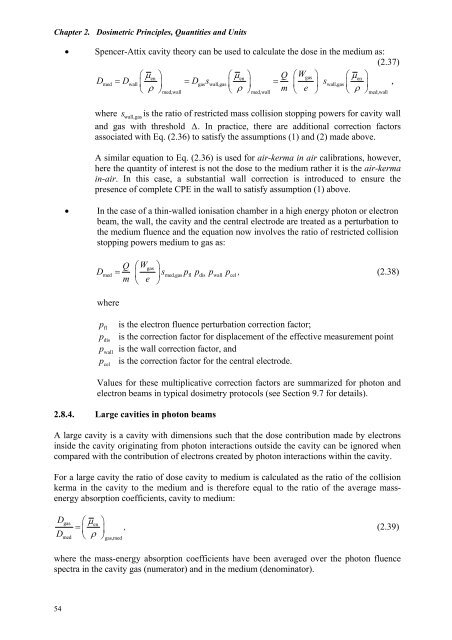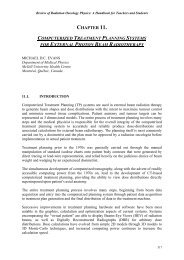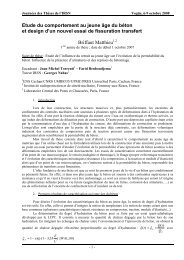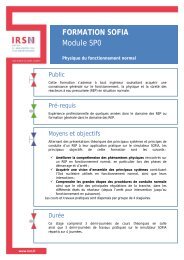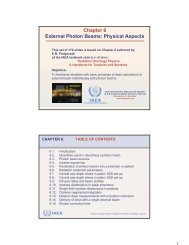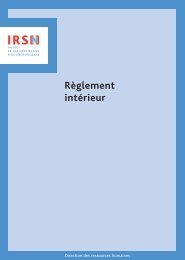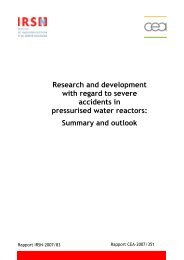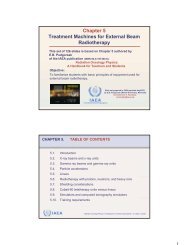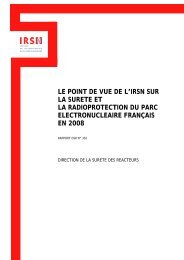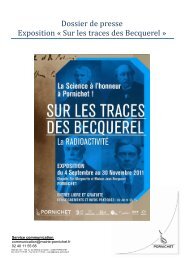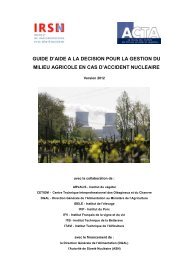chapter 2. dosimetric principles, quantities and units - IRSN
chapter 2. dosimetric principles, quantities and units - IRSN
chapter 2. dosimetric principles, quantities and units - IRSN
You also want an ePaper? Increase the reach of your titles
YUMPU automatically turns print PDFs into web optimized ePapers that Google loves.
Chapter <strong>2.</strong> Dosimetric Principles, Quantities <strong>and</strong> Units• Spencer-Attix cavity theory can be used to calculate the dose in the medium as:(<strong>2.</strong>37)⎛µ en⎞ ⎛µen⎞ Q ⎛Wgas⎞ ⎛µen⎞Dmed = Dwall ⎜ ⎟ = Dgas swall,gas ⎜ ⎟ = ⎜ ⎟ swall,gas⎜ ⎟ ,⎝ ρ ⎠ ⎝ ρ ⎠ m ⎝ e ⎠ ⎝ ρ ⎠med,wall med,wall med,wallwhere s wall,gasis the ratio of restricted mass collision stopping powers for cavity wall<strong>and</strong> gas with threshold ∆. In practice, there are additional correction factorsassociated with Eq. (<strong>2.</strong>36) to satisfy the assumptions (1) <strong>and</strong> (2) made above.A similar equation to Eq. (<strong>2.</strong>36) is used for air-kerma in air calibrations, however,here the quantity of interest is not the dose to the medium rather it is the air-kermain-air. In this case, a substantial wall correction is introduced to ensure thepresence of complete CPE in the wall to satisfy assumption (1) above.• In the case of a thin-walled ionisation chamber in a high energy photon or electronbeam, the wall, the cavity <strong>and</strong> the central electrode are treated as a perturbation tothe medium fluence <strong>and</strong> the equation now involves the ratio of restricted collisionstopping powers medium to gas as:Q ⎛W⎞D = ⎜ ⎟s p pm ⎝ e ⎠gasmed med,gas fl dis wall celwherep flp p , (<strong>2.</strong>38)is the electron fluence perturbation correction factor;p disis the correction factor for displacement of the effective measurement pointp wallis the wall correction factor, <strong>and</strong>p celis the correction factor for the central electrode.Values for these multiplicative correction factors are summarized for photon <strong>and</strong>electron beams in typical dosimetry protocols (see Section 9.7 for details).<strong>2.</strong>8.4. Large cavities in photon beamsA large cavity is a cavity with dimensions such that the dose contribution made by electronsinside the cavity originating from photon interactions outside the cavity can be ignored whencompared with the contribution of electrons created by photon interactions within the cavity.For a large cavity the ratio of dose cavity to medium is calculated as the ratio of the collisionkerma in the cavity to the medium <strong>and</strong> is therefore equal to the ratio of the average massenergyabsorption coefficients, cavity to medium:DDgasmed⎛µ⎞en= ⎜ ⎟⎝ ρ ⎠gas,med, (<strong>2.</strong>39)where the mass-energy absorption coefficients have been averaged over the photon fluencespectra in the cavity gas (numerator) <strong>and</strong> in the medium (denominator).54


